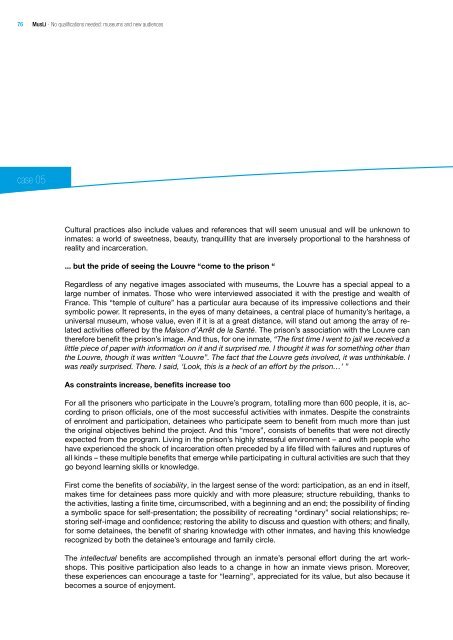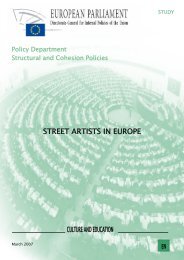MusLi (Museums Literacy) - Fondazione Fitzcarraldo
MusLi (Museums Literacy) - Fondazione Fitzcarraldo
MusLi (Museums Literacy) - Fondazione Fitzcarraldo
You also want an ePaper? Increase the reach of your titles
YUMPU automatically turns print PDFs into web optimized ePapers that Google loves.
76 <strong>MusLi</strong> - No qualifications needed: museums and new audiences<br />
case 05<br />
Cultural practices also include values and references that will seem unusual and will be unknown to<br />
inmates: a world of sweetness, beauty, tranquillity that are inversely proportional to the harshness of<br />
reality and incarceration.<br />
... but the pride of seeing the Louvre “come to the prison “<br />
Regardless of any negative images associated with museums, the Louvre has a special appeal to a<br />
large number of inmates. Those who were interviewed associated it with the prestige and wealth of<br />
France. This “temple of culture” has a particular aura because of its impressive collections and their<br />
symbolic power. It represents, in the eyes of many detainees, a central place of humanity’s heritage, a<br />
universal museum, whose value, even if it is at a great distance, will stand out among the array of related<br />
activities offered by the Maison d’Arrêt de la Santé. The prison’s association with the Louvre can<br />
therefore benefit the prison’s image. And thus, for one inmate, “The first time I went to jail we received a<br />
little piece of paper with information on it and it surprised me. I thought it was for something other than<br />
the Louvre, though it was written “Louvre”. The fact that the Louvre gets involved, it was unthinkable. I<br />
was really surprised. There. I said, ‘Look, this is a heck of an effort by the prison…’ ”<br />
As constraints increase, benefits increase too<br />
For all the prisoners who participate in the Louvre’s program, totalling more than 600 people, it is, according<br />
to prison officials, one of the most successful activities with inmates. Despite the constraints<br />
of enrolment and participation, detainees who participate seem to benefit from much more than just<br />
the original objectives behind the project. And this “more”, consists of benefits that were not directly<br />
expected from the program. Living in the prison’s highly stressful environment – and with people who<br />
have experienced the shock of incarceration often preceded by a life filled with failures and ruptures of<br />
all kinds – these multiple benefits that emerge while participating in cultural activities are such that they<br />
go beyond learning skills or knowledge.<br />
First come the benefits of sociability, in the largest sense of the word: participation, as an end in itself,<br />
makes time for detainees pass more quickly and with more pleasure; structure rebuilding, thanks to<br />
the activities, lasting a finite time, circumscribed, with a beginning and an end; the possibility of finding<br />
a symbolic space for self-presentation; the possibility of recreating “ordinary” social relationships; restoring<br />
self-image and confidence; restoring the ability to discuss and question with others; and finally,<br />
for some detainees, the benefit of sharing knowledge with other inmates, and having this knowledge<br />
recognized by both the detainee’s entourage and family circle.<br />
The intellectual benefits are accomplished through an inmate’s personal effort during the art workshops.<br />
This positive participation also leads to a change in how an inmate views prison. Moreover,<br />
these experiences can encourage a taste for “learning”, appreciated for its value, but also because it<br />
becomes a source of enjoyment.






